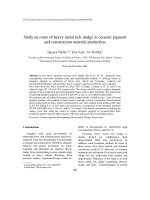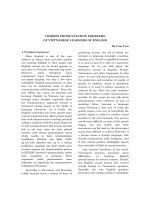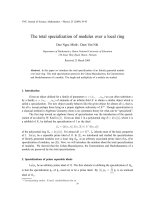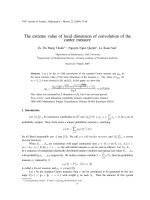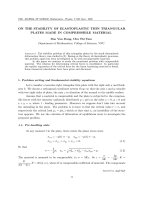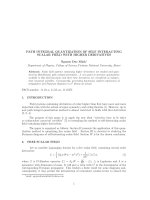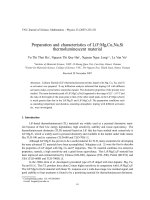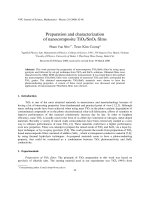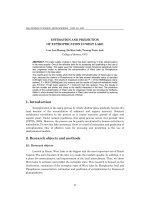Tài liệu Báo cáo " Common pronunciation problems of vietnamese learners of english " docx
Bạn đang xem bản rút gọn của tài liệu. Xem và tải ngay bản đầy đủ của tài liệu tại đây (219.03 KB, 11 trang )
Common pronunciation problems
of vietnamese learners of english
Ha Cam Tam
1. Problem statement
Since English is one of the core
subjects at school, more and more schools
are teaching English to their pupils and
English centres can be found popular in
any cities in Vietnam, especially big cities.
However, many foreigners have
commented “many Vietnamese speakers
can speak English, but only a few have
intelligible English pronunciation so that
they can be understood easily in direct
communication with foreigners.” Since the
late 1980s, the course of teaching and
learning English in Vietnam has gone
through many changes, especially when
the communicative approach became a
buzzword among people in the fields of
language education. As a result, the
English curriculum has been geared more
toward communication. Most people hoped
that with communicative teaching oriented
syllabus students would be much improved
in oral communication. But it turns out that
this is not true, since we have noticed
learners with serious pronunciation errors
which results in their communication
breakdown. Hinofitis and Baily (1980,
pp.124-125) reported that up to a certain
proficiency standard, the fault which most
severely impairs the communication process
in EFL/ESL learners is pronunciation, rather
than vocabulary or grammar. Their
arguments make pronunciation more
important in improving the communicative
competence of learners.
According to Davenport and Hannahs
(1998) humans have a variety of ways of
producing sounds, not all of which are
relevant to language (example: coughing,
burping, etc.). Sound is significant because
it is used as part of a code of a particular
language. So we can talk about the
distinctive sounds of English, French,
Vietnamese and other languages. In this
sense, we can talk about pronunciation as
the production and reception of sounds of
speech. In addition, sound is significant
because it is used to achieve meaning in
contexts of use. Here, the code combines
with other factors to make communication
possible. In this sense, we can talk about
pronunciation with reference to acts of
speaking. Since, learning a language
means learning a new way of using the
speech organs, new way of controlling the
speech organs in order to produce sound
peculiar to the new language, this process
can be more difficult as some of the speech
organs are not visible and their
movements are far back in the pharyngeal
cavity thus difficult to control. However, if
a person learns a foreign language, s/he
should communicate with foreigners, and
if s/he cannot produce intelligible speech
they certainly will fail in communication.
Like learners elsewhere in the world,
Vietnamese learners encounter great
difficulties in learning English
pronunciation for several reasons. Firstly,
the English sound system has several
sounds foreign to Vietnamese speakers.
Secondly, the way English speakers
pronounce the ending sounds is completely
different from the one deeply rooted in
Vietnamese speakers, making it more
difficult for them to achieve appropriate
English pronunciation. Consequently,
Vietnamese learners have been reported to
make phonetic errors leading to
incomprehensible speech in English. In an
attempt to deal with the pronunciation
problem of the students at the English
department I have carried out this study to
find out their common pronunciation errors.
2. Theoretical issues
2.1. The English Sounds
2.1.1 Fortis and lenis
A voiceless/voiced pair such as [s, z] are
distinguished not only by the presence or
absence of voice but also by the degree of
breath and muscular effort involved in the
articulation. We shall see that on the
linguistic level, in certain situations, the
voice opposition may be lost, so that the
energy of articulation becomes a
significant factor. Those English
consonants which are usually tend to be
articulated with relatively weak energy,
whereas those which are always voiceless
are relatively strong. Thus, it may be
important to define [s], for instance, as
strong or fortis and [z] as weak or lenis.
Fortis consonants normally shorten the
preceding vowels, while lenis consonants
often lengthen the preceding vowels.
2.1.2. The English Consonants
2.1.2.1. Stop consonants (plosives)
A plosive is a consonant articulation
with the following characteristics:
1) The closing stage, during which the
articulating organs move together in order
to form the obstruction; in this stage, there
is often an on-glide or transition audible in
a preceding sound segment and visible in
an acoustic analysis as characteristic curve
of formants of the preceding sound;
2) The hold or compression stage,
during which lung action compresses the
air behind the closure; this stage may or
may not be accompanied by voice, i.e.
vibration of the vocal cords;
3) The release or explosion stage,
during which the organs forming the
obstruction part rapidly, allowing the
compressed air to escape abruptly; if stage
(2) is voiced, the vocal cord vibration may
continue in stage (3); if stage (2) is voiceless,
stage (3) may also be voiceless (aspiration)
before silence or before the onset of voice.
English has six plosive consonants: p,
t, k, b, d, g. These plosives have different
places of articulation.
• Bilabial Plosives: /p, b/
The soft palate being raised and the
nasal resonator shut off, the primary
obstacle to the air-stream is provided by
the closure of the lips. Lung air is
compressed behind this closure, during
which stage the vocal cords are held wide
apart for /p/, but may vibrate for all or part
of the compression stage for /b/ according
to its situation in the utterance. Then the
closure is released suddenly for the air to
escape with a kind of explosion.
• Alveolar Plosives: /t, d/
The soft palate being raised and the
nasal resonator shut off, the primary
obstacle to the air-stream is formed by a
closure made between the tip and rims of
the tongue and the upper alveolar ridge
and side teeth. Lung air is compressed
behind this closure, during which stage the
vocal cords are wide apart for /t/, but may
vibrate for all or part of the compression stage
for /d/ according to its situation in the
utterance. The air escapes with noise upon
the sudden separation of the alveolar closure.
• Velar Plosives: /k, g/
The soft palate being raised and the
nasal resonator shut off, the primary
obstacle to the air-stream is formed by a
closure made between the back of the
tongue and the soft palate. Lung air is
compressed behind this closure, during
which stage the vocal cords are wide apart
for /k/, but may vibrate for all or part of
the compression stage for /g/ according to
its situation in the utterance. The air
passage escapes with noise upon the
sudden separation of the velar closure.
All six plosives can occur at the
beginning of a word (initial position),
between other sounds (medial position)
and at the end of a word (final position).
2.1.2.2. Fricatives
Fricatives are consonants with the
characteristic that when they are
produced, air escapes through a small
passage and makes a hissing sound
sometimes called “riction”. Fricatives are
continuant consonants, as you can
continue making them without
interruption as long as you have enough
air in your lungs.
• Labio-dental Fricatives: /f, v/
The soft palate being raised and the
nasal resonator shut off, the inner surface
of the lower lip makes a light contact with
the edge of the upper teeth, so that the
escaping air produces friction. For /f/, the
friction is voiceless, whereas there may be
some vocal cord vibration accompanying
/v/, according to its situation.
• Dental Fricatives: /ð, θ/
(Examples words: thumb, thus, either,
father, breath, breathe)
The soft palate being raised and the
nasal resonator shut off, the tip and rims
of the tongue make a light contact with the
edge and inner surface of the upper
incisors and a firmer contact with the
upper side teeth, so that the air escaping
between the forward surface of the tongue
and the incisors causes friction. For / θ /
the friction is voiceless, whereas for / ð/
there may be some vocal cord vibration.
• Alveolar Fricatives: /s, z/
(Examples words: sip, zip, facing, rise,
rice)
The soft palate being raised and the
nasal resonator shut off, the tip and blade
of the tongue make a light contact with the
upper alveolar ridge, and the side rims of
the tongue a close contact with the upper
side teeth. The air-stream escapes through
the narrow groove in the centre of the
tongue and causes friction between the
tongue and the alveolar ridge. In other
words, in the articulation of these sounds
the air escapes through a narrow passage
along the centre of the tongue, and the
sound produces is comparatively intense.
• Palato-alveolar Fricatives: / ʃ; ʒ /
(example words: ship, Russia, measure,
Irish, garage)
The fricatives are so called palato-
alveolar, which can be taken to mean that
their place of articulation is partly palatal,
partly alveolar. The tongue is in contact
with an area slightly further back than
that for /s/, /z/. If you make /s/ then / ʃ /,
you should be able to feel your tongue
move backwards. The air escapes through
a passage along the centre of the tongue,
as in /s/ and /z/, but the passage is a little
wider. Most speakers of RP have rounded
lips for / ʃ / and / ʒ /, and this is an
important difference between these
consonants and /s/ and /z/. In addition, the
escape of air is diffuse (compared with that
of /s, z/), the friction occurring between a
more extensive area of the tongue and the
roof of the mouth. In the case of / ʃ /, the
friction is voiceless, whereas for / ʒ / there
may be some vocal cord vibration
according to its situation.
All the fricatives described so far can
be found in initial, medial and final
positions. In the case of / ʒ/, however, the
distribution is much more limited. Very
few English words begin with / ʒ/ (most of
them have come into the language
comparatively recently from French) and
not many end with this consonant. Only
medially, in words such as “measure”,
‘usually’ is it found at all commonly.
• Glottal Fricative: /h/
The place of articulation of this
consonant is glottal. This means that the
narrowing that produce the friction noise
is between the vocal folds. When we
produce /h/ in speaking English, many
different things happen in different
contexts. In the word ‘hat’, the /h/ must be
followed by an / æ / vowel. The tongue, jaw
and lip positions for the vowel are all
produced simultaneously with the /h/
consonant, so that the glottal fricative has
an / æ / quality. The same is found for all
vowels following /h/.
2.1.2.3. Affricates
Affricates are rather complex consonants.
They begin as plosives and end as fricatives.
• Affricates: /ʧ ; ʤ /
(Palato-alveolar affricates)
The term “affricates” denotes a concept
which is primarily of phonetic importance.
Any plosive, whose release stage is
performed in such a way that considerable
friction occurs approximately at the point
where the plosive stop is made, may be
called “affricative”. The friction present in
an affricate is of shorter duration than
that which characterizes the fricatives
proper. In the articulation of / ʧ; ʤ / the
soft palate being raised and the nasal
resonator shut off, the obstacle to the air-
stream is formed by a closure made
between the tip, blade, and rims of the
tongue and the upper alveolar ridge and
side teeth. At the same time, the front of
the tongue is raised towards the hard
palate in readiness for the fricative
release. The closure is released slowly, the
air escaping in a diffuse manner over the
whole of the central surface of the tongue
with friction occurring between the
blade/front region of the tongue and the
alveolar/front palatal section of the roof of
the mouth. During both stop and fricative
stages, the vocal cords are wide apart for / ʧ /,
but may be vibrating for all or part of / ʤ /
according to the situation in the utterance.
2.1.2.4. Nasals
• Bilabial Nasal: /m/
The lips form a closure as for /p, b/; the
soft palate is lowered, adding the
resonance of the nasal cavity to those of
the pharynx and the mouth chamber
closed by the lips; the tongue will generally
anticipate or retain the position of the
adjacent vowel.
• Alveolar Nasal: /n/
The tongue forms a closure with the
teeth ridge and upper side teeth as for /t,
d/; the soft palate is lowered, adding the
resonance of the nasal cavity to those of
the pharynx and of that part of the mouth
chamber behind the alveolar closure; the
lip position will depend upon that of
adjacent vowels.
• Velar Nasal: /ŋ/
A closure is formed in the mouth
between the back of the tongue and the
velum as for /k, g/ (the point of closure will
depend on the type of vowel preceding); the
soft palate is lowered, adding the
resonance of the nasal cavity to that of the
pharynx and that small part of the mouth
chamber behind the velar closure.
2.1.2.5. Lateral
Only one alveolar, lateral phoneme
occurs in English, there being no
opposition between fortis and lenis, voiced
or voiceless, or fricative and non-fricative.
Within the /l/ phoneme three main
allophones occur:
- Clear [l], with a relatively front vowel
resonance, before vowels and /j/.
- Voiceless [l
0
], following aspirated /p, k/.
- Dark [ł], with a relatively back vowel
resonance, finally after a vowel, before a
consonant, and as syllabic sound following
a consonant.
For clear [l], the front of the tongue is
raised in the direction of the hard palate at
the same time as the tip contact is made.
For dark [ł], the tip contact is again made
on the teeth ridge, the front of the tongue
being somewhat depressed and the back
raised in the direction of the soft palate,
giving a back vowel resonance.
Both [l] and [ł] are voiced, though
partial devoicing may take place when a
preceding consonant is fortis. The actual
point of contact of the tongue for [ł] is
conditioned by the place of articulation of
the following consonant; thus, in health,
will they, the [ł] has a dental contact, but
in already, ultra, all dry, the contact for [ł]
is likely to be post-alveolar.
2.1.2.6. Variations of the plosives
• Alveolar Approximant: /r/
The most common allophone of RP /r/ is a
voiced post-alveolar frictionless
approximant. The soft palate being raised
and the nasal resonator shut off, the tip of
the tongue is held in a position near to, but
not touching, the rear part of the upper
teeth ridge; the central part of the tongue
is lowered with a general contraction of the
tongue. The air stream is thus allowed to
escape freely, without friction, over the
centre part of the tongue.
• Palatal Approximant: /j/
The vocalic allophones of RP /j/ are
articulated by the tongue assuming the
position for a front half-close to close vowel
and moving away immediately to the
position of the following sound; the lips are
generally neutral or spread. When /j/
follows a fortis consonant such as /p/, /k/,
devoicing takes place.
• Labio-velar Approximant: /w/
The vocalic allophones of RP /w/ are
articulated by the tongue assuming the
position for a back half-close to close vowel
and moving away immediately to the
position of the following sound; the lips are
rounded. The soft palate is raised and the
vocal cords vibrate; but when /w/ follows a
fortis consonant, some devoicing takes place.
2.2. Variations of the Plosives
As has been mentioned, all plosives can
occur at the beginning of a word (initial
position), between other sounds (medial
position), and at the end of a word (final
position).
Initial position: the closure phase for p,
t, k and b, d, g takes place silently. During
the whole phase there is no voicing in p, t,
k; in b, d, g there is normally very little
voicing. The release of p, t, k followed by
audible plosion, that is a burst of noise.
There is then, in the post-release phase, a
period during which air escapes through
the vocal folds, making a sound like h.
This is called aspiration. The most
noticeable and important difference, then,
between initial p, t, k and b, d, g is the
aspiration of the voiceless plosives p, t, k.
In initial position b, d, g cannot be
preceded by any consonant, but p, t, k may
be preceded by s. When one of p, t, or k is
preceded by s it is not aspirated.
Medial position: depending on whether
the syllables preceding and following the
plosives are stressed or not, the medial
plosives may have the characteristics
either of final or of initial plosives.
Final position: the final sounds such as
b, d, g normally have little voicing; if there
is voicing, it is at the beginning of the hold
phase. p, t, k are, of course, voiceless. The
plosion following the release of p, t, k and
b, d, g is very weak and often not audible.
The difference between p, t, k and b, d, g is
primarily the fact that vowels preceding p,
t, k are much shorter.
Following is the presentation of some
variations of the plosives or stops in English.
2.2.1. Incomplete plosion: Stop + Stop
When one stop consonant is
immediately followed by another, as in
[kept] and [ækt], or at word boundaries
such as white post (/t/ + /p/), top boy (/t/ +
/b/), the closure of the speech organs for
the second consonant is made whilst the
closure for the first consonant is still in
position. In the sequence of /pt/ this is
what happens: the lips are closed for p and
air is compressed as usual by pressure
from the lungs; then, with the lips still
closed, the tongue-tip is placed on the
alveolar ridge ready for /t/, so that there
are two closures. Then, and only then, the
lips are opened, but there is no explosion of
air because the tongue closure prevents
the compressed air from bursting out of
the mouth; finally, the tongue-tip leaves
the alveolar ridge and air explodes out of
the mouth. So there is only one explosion for
the two stops; the first stop is incomplete.
2.2.2. Nanal plosion: Stop + Nasal
When /t/ or /d/ is followed by a syllabic
/n/, the explosion of the stop takes place
through the nose, e.g. bitten, or garden.
This nasal explosion happens in this way:
the vocal organs form t or d in the usual
way, with the soft palate raised to shut off
the nasal cavity and the tongue-tip on the
alveolar ridge, but instead of taking the
tongue-tip away from the alveolar ridge to
give the explosion we leave it in the same
position and lower the soft palate, so that
the breath explodes out of the nose rather
than out of the mouth.
2.2.3. Lateral plosion: Stop + Lateral
When the stop consonant /t/ or /d/ is
followed by lateral /l/, the t and d are made
with the tongue-tip on the alveolar ridge and
the sides of the tongue firmly touching the
sides of the palate; /l/ is made with the
tongue-tip touching the alveolar ridge, but
the sides of the tongue away from the sides of
the palate so that the breath passes out
laterally. The simplest way to go from /t/ or /d/
to /l/ is to leave the tongue-tip on the alveolar
ridge and only lower the sides, and that is
what we do. It is called lateral explosion.
2.3. English Vowels
Vowels are made by voiced air passing
through different mouth-shapes; the
differences in the shape of the mouth are
caused by different positions of the tongue
and of the lips. The quality of vowels is
determined by the particular configuration
of the vocal tract. Different parts of the
tongue may be raised or lowered. The lips
may be spread or pursed. The passage,
through which the air travels, however, is
never so narrow as to obstruct free flow of
the air stream. Thus vowels have been
traditionally classified according to the
three questions:
How high is the tongue?
What part of the tongue is involved; that
is, what part is raised? What part is lowered?
Is the vowel rounded or not?
Due to typographic difficulties, detailed
description of vowels will not be presented
(refer to Tam, 1999 for more information).
3. Methodology
This study was set up to answer the
following question:
What are the most common
pronunciation problems of the students in
the English department?
The data collection was administered
through an oral examination. This is the
final oral exam students (except for those
who were eligible to write theses) have to
participate in order be awarded the
university degree. During the exam, each of
the students was requested to present a talk
about a particular topic in approximately five
minutes. While listening to students talking,
the researcher took notes of the errors
related to pronunciation.
The subjects of the study were
students of the English department who
had finished four years of English and took
part in the final exam. They were all aged
between twenty and twenty three.
Unfortunately, it was impossible for the
researcher to get equal number of male
and female students since the researcher
was assigned to be an examiner for one
examination room out of more than
twenty, and most of the students of the
department were female. However, since
most language students are female, it
might be more appropriate to analysis the
errors made by female students rather
than male students. The data used for this
analysis were collected through three
exams with the total of fifty one students.
4. Data analysis
Table 1. Common errors found in the data
Types of errors No. of subjects with
errors
medial: l, ʤ, r, s, i, ei, k
19
Sound
Omitted
final: z, s, t, v, ks, ʤ
25
t = ʧ
13
tr = ʧ
16
ð = z/d
10
ʃ = s
15
ʤ = /j/d/s/t/z/ʧ/
13
s = /ʃ/ʒ/
11
p = b; ʧ = s
9
Sound
confusion
θ= /s/t/ ; r = z
7
Sound
redundancy
s, z, 13
As has been shown in Table 1, there
were three main types of errors found in
the data. Among them the most common
errors were sound omission in which
omission of ending sounds were more
frequent than others. It is easy to
understand why ending sounds were
omitted so frequently, because in
Vietnamese speakers do not have to
pronounce the ending sounds. In addition,
some of the sounds, such as /ʒ, ʤ, ʧ / are
really hard for Vietnamese learners to
pronounce especially when these sounds
occur at the end of words. From our
experience, teachers usually have to spend
a lot of time helping learners practice
these sounds, as many find them difficult
to pronounce. Considering, for example,
the manner of articulation of / ʒ /: the air-
stream escapes through the narrow groove
in the centre of the tongue and causes
friction between the tongue and the
alveolar ridge. This is normally difficult for
Vietnamese learners because we do not have
the same sound in our language, especially
when this sound occurs at the final position
of a word, the act of holding the tongue
against the alveolar ridge for the air to pass
through with some friction is a completely
new concept for many learners.
The habit of “swallowing” the ending
sound in the mother tongue is in fact a
negative transference that inhibits the
pronunciation of ending sounds in the
target language. In addition, the
properties of these two sounds are also a
new concept to them. With this particular
sound /z/, many learners try to pronounce
them but often end up with /s/ instead, just
because they usually push the air through
too hard. It should be noted that in making
/s/ and /z/ distinct the opposition of fortis
vs. lenis plays an important role. It is the
teacher’s task to help learners fully aware
of this distinction in order to articulate the
sounds correctly.
In reference to the omission of sounds
in medial position, combinations of
consonants are frequently found. It is
explainable that this way of controlling the
speech organs is unfamiliar to Vietnamese
learners, as Vietnamese is monosyllabic
language, so we never have to pronounce
cluster of consonants. However, in our
data, most of the examples in which
informants could not pronounce the words
correctly include clusters of two or three
consonants. To most Vietnamese speakers,
the completely different thing
encountering Vietnamese learners is that
all sounds in an English word should be
pronounced, although some sounds in the
middle may be partially pronounced, but
the speech organs have to move to the
required position and then move towards
other position for the following sound.
Compared to the way Vietnamese is
spoken, this is really a hard thing for
Vietnamese learners. This suggests that in
teaching English pronunciation, the
emphasis should be placed in these areas,
the pronunciation of ending and medial
consonants.
Regarding the second type of errors,
sound confusion, the most frequent errors
are t, tr, ʧ, ʃ, ʤ, s, θ. It is interesting to
find that several learners mispronounced
/t/ and produced /ʧ/ instead. The
mispronunciation of this sound may be due
to the misperception of the aspiration of
this sound. As we saw in the theoretical
background, the sound /t/ is a plosive or
stop consonant. According to English
phonological rules (Roach, 1990), this
sound is fully aspirated at word initial, but
not aspirated in between voiced sounds
such as in “interpreter”. Since learners
forgot that /t/ is only aspirated in initial
position, so they tried to make it aspirated
in all environments, thus leading to the
mispronunciation of the sound. In
addition, as /t/ was pronounced as /ʧ/, this
indicates that speakers were confused
about the pronunciation of plosives and
affricatives. Affricatives are plosives plus
fricatives produced by holding the
articulators in contact a little bit longer so
that friction can be formed. Some
Vietnamese learners cannot distinguish
between aspiration and friction and they
often produce them interchangeably which
makes their speech hard to understand.
Furthermore, results also show that
many informants made mistakes in
producing /tr/. From my experience, this
error is very common among students of
the English department; the combination
of /tr/ seems to be very difficult for many of
them, especially for students from the
country. The reason might be that this
combination is unfamiliar to Vietnamese
speakers, as there is no such combination
in their mother tongue. Besides, students
do not seem to know how this combination
should be articulated and do not try to find
out about this.
Next, the mispronunciation of s to /ʃ, ʒ/
or /ʃ, ʒ/ to s seems to be related to the
carelessness ɔand laziness of the students.
The students who made this kind of mistakes
usually do not try to find out how the tongue
act in each case, instead they make all these
sounds similar which results in their
mispronunciation as was found in this study.
Finally, the type of errors called “sound
redundancy” seems to indicate that several
learners tend to over pronounce the ending
sounds, thus adding s or z at the end of
any words or sometimes in the middle of
the words as in the case of hobby, many
pronounced it as
/hɔzbi/. This is a very bad
habit that always leads to miscommunication
and yet not all teachers take it serious enough
to correct them. Since this kind of errors
always leads to miscommunication, students
should be warned about this and corrected
immediately.
In conclusion, the results of this study
show
(1)
that:
a) The sounds most frequently
mispronounced by the informants include
(1)
For more details please refer to “Bao dong ve ngu
am” in proceedings of Language conference, English
Department, National University of Hanoi, 2002.
Order Sound Mispronunciation
1
2
3
4
5
6
7
8
9
10
11
θ
s
tr
t
ʃ
ʤ
ʧ
t
v
ʒ
ť
ʃ
ʧr ; ʧ
ʧ, s
z
z , ʧ, t, j, ʒ, s
ʃ, ʒ, z
ʃ, ch, s,
f
z ʧ, ʤ
Among these errors the most frequent
was the combination of /tr/. Many students
could not pronounce this combination
correctly and mispronounced them in
many different words. The second most
frequent errors were ʃ, ʤ, ʧ. These
sounds at final position were replaced by s,
z; ʧ, ʃ, z; ʃ, ch, s (the symbol “ch” is used
to indicate the sound /ʧ/ when the
learners produced the sound similar to the
initial sound in Vietnamese words such as
“cho (dog), cho (market).”
b) Words that were most commonly
mispronounced include:
the
job
knowledge
your
especially
usually
English
teacher
person
relax
appreciate
centre
teacher
try
tradition
train
good
interpreter
country
Translate
person
c) Sounds that were most frequently
omitted include
/s, z, ʤ, t, l, k, ks, v/ at all positions such
as help, difficult, agriculture, parents, because,
sister, etc, in our data these sounds were omitted
in at least 15 words and by several students.
d) Redundant sounds most frequently
found in the data include:
The most frequently redundant sounds
are /z; s/. In our data there were 13 words
mispronounced in this way. Interestingly,
several students did not pronounce these
sounds in words where they occurred,
however, added them to other words such
as “goods”, “peoples” etc.
e) Comments on mispronounced words
The most frequently mispronounced
words include job, country, centre, the,
English, tradition etc. Most of these belong to
the basic vocabulary stock. According to
UCLES there are about 2500 words
considered as most essential which form the
basic stock of words that most upper-
intermediate and advanced need for their
communication. Unfortunately, most of
the words mispronounced in our data
belong to this basic stock including very
frequently used words such as job,
centre, the, English etc.
5. Conclusion
We have presented the results of our
study, although small but the results were
fairly impressive in terms of the coverage
of sounds mispronounced as well as the
seriousness of errors. Given the
pronunciation problems, I would like to
suggest the following remedy:
a) We request that all teachers of the
English department pay more attention to
students pronunciation and try to correct
them any time possible. I would like to
stress that the task of improving students
pronunciation is the responsibility of all
teachers, not only teachers of phonetics.
b) Since language learning, like music,
painting or architecture, requires some gift
from learners, aptitude test would be
necessary in order to get rid of students
who have language deficiency, for instance
people with confusion of /l/ and /n/. In
terms of economy and efficiency language
deficiency people working as language
teachers would be very dangerous and
costly. It is dangerous because many of
their students will make the same errors,
thus, the disease spreads. It is costly
because many students who innocently
imitate their errors will have to spend plenty
of time and energy for their retraining.
c) As language aptitude exam is still not
possible, it would be desirable to use task
force periods for pronunciation practice to
help improve their pronunciation.
Finally, it is necessary to conduct a
more comprehensive study in this area so
as to identify more substantial information
concerning pronunciation problem of our
students that will help us determine a
more appropriate pronunciation program
for our students.
Reference
1. Davenport, M and Hannahs, S. J., Introducing phonetics and phonology, Great Britain:
Arnold, 1998.
2. Hinofotis, F and Baily, K., American undergraduate reaction to the communication skills of
foreign teaching assistants, TESOL 80: Building Bridges: Research and Practice in TESL,
Alexandria, V.A, 1980.
3. Roach, P., English phonetics and phonology - A practical course, Cambridge: Cambridge
University Press, 1990.
4. Tam Ha Cam, English phonetics and phonology, A course book for students of the English
department, Đại học Quốc gia Hà Nội, 1999.
5. Tam Ha Cam, Báo động về ngữ âm, Những điều tìm thấy qua hai lần hỏi thi vấn đáp, Kỷ
yếu hội nghị khoa học Khoa Ngôn ngữ và Văn hóa Anh Mỹ, 2002.
6. Yallop, C., English phonology, Sydney NSW: Macquarie University, 1995.
